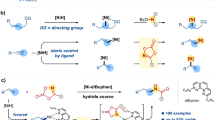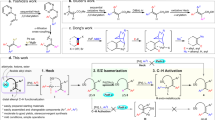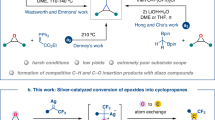Abstract
The recognition of structural elements (that is, retrons) that signal the application of specific chemical transformations is a key cognitive event in the design of synthetic routes to complex molecules. Reactions that produce compounds without an easily identifiable retron, by way of either substantial structural rearrangement or loss of the atoms required for the reaction to proceed, are significantly more difficult to apply during retrosynthetic planning, yet allow for non-traditional pathways that may facilitate efficient acquisition of the target molecule. We have developed a triflimide (Tf2NH)-catalysed rearrangement of N-allylhydrazones that allows for the generation of a sigma bond between two unfunctionalized sp3 carbons in such a way that no clear retron for the reaction remains. This new ‘traceless’ bond construction displays a broad substrate profile and should open avenues for synthesizing complex molecules using non-traditional disconnections.
This is a preview of subscription content, access via your institution
Access options
Subscribe to this journal
Receive 12 print issues and online access
$259.00 per year
only $21.58 per issue
Buy this article
- Purchase on Springer Link
- Instant access to full article PDF
Prices may be subject to local taxes which are calculated during checkout




Similar content being viewed by others
References
Castro, A. M. M. Claisen rearrangement over the past nine decades. Chem. Rev. 104, 2939–3002 (2004).
Corey, E. J. & Cheng, X.-M. The Logic of Chemical Synthesis (Wiley, 1989).
Chen, C., Layton, M. E., Sheehan, S. M. & Shair, M. D. Synthesis of (+)-CP-263,114. J. Am. Chem. Soc. 122, 7424–7425 (2000).
Stevens, R. V., McEntire, E. E., Barnett, W. E. & Wenkert, E. Thermally induced [3,3] sigmatropic rearrangement of N-allylhydrazones. Chem. Commun. 662–663 (1973).
Vedejs, E. & Stolle, W. T. Reductive alkylation of aldehyde tosylhydrazones with organolithium reagents. Tetrahedron Lett. 18, 135–138 (1977).
Bertz, S. H. The preparation of hindered cuprates from aldehyde tosylhydrazones. Tetrahedron Lett. 21, 3151–3154 (1980).
Myers, A. G. & Kukkola, P. J. Stereoselective synthesis of olefins from silylated sulfonylhydrazones. J. Am. Chem. Soc. 112, 8208–8210 (1990).
Myers, A. G. & Movassaghi, M. Highly efficient methodology for the reductive coupling of aldehyde tosylhydrazones with alkyllithium reagents. J. Am. Chem. Soc. 120, 8891–8892 (1998).
Barluenga, J., Tomás-Gamasa, M., Aznar, F. & Valdés, C. Metal-free carbon–carbon bond-forming reductive coupling between boronic acids and tosylhydrazones. Nature Chem. 1, 494–499 (2009).
Mundal, D. A., Lee, J. J. & Thomson, R. J. Tandem carbon–carbon and carbon–chlorine bond formation by Cu(II) chloride-promoted [3,3] sigmatropic rearrangement of N-allylhydrazones. J. Am. Chem. Soc. 130, 1148–1149 (2008).
Mundal, D. A., Lutz, K. E. & Thomson, R. J. Stereoselective synthesis of dienes from N-allylhydrazones. Org. Lett. 11, 465–468 (2009).
Akiyama, T. Stronger Brønsted acids. Chem. Rev. 107, 5744–5758 (2007).
Taber, D. F. & Houze, J. B. The 2-hydroxycitronellols, convenient chirons for natural products synthesis. J. Org. Chem. 59, 4004–4006 (1994).
Myers, A. G., Movassaghi, M. & Zheng, B. Mechanistic studies of the free-radical fragmentation of monoalkyl diazenes. Tetrahedron Lett. 38, 6569–6572 (1997).
Saito, B & Fu, G. C. Alkyl–alkyl Suzuki cross-couplings of unactivated secondary alkyl halides at room temperature. J. Am. Chem. Soc. 129, 9602–9603 (2007).
Saito, B & Fu, G. C. Enantioselective alkyl–alkyl Suzuki cross-couplings of unactivated homobenzylic halides. J. Am. Chem. Soc. 130, 6694–6695 (2008).
Son, S. & Fu, G. C Nickel-catalyzed asymmetric Negishi cross-couplings of secondary allylic chlorides with alkylzincs. J. Am. Chem. Soc. 130, 2756–2757 (2008).
Acknowledgements
This work was supported by the National Science Foundation (CHE0845063), the donors of the American Chemical Society Petroleum Research Fund (grant no. 46778-G) and Northwestern University.
Author information
Authors and Affiliations
Contributions
R.J.T. conceived the idea and wrote the manuscript. D.A.M. and C.T.A. performed the experiments. All the authors analysed the data, contributed to discussions and edited the manuscript.
Corresponding author
Ethics declarations
Competing interests
The authors declare no competing financial interests.
Supplementary information
Supplementary information
Supplementary information (PDF 15988 kb)
Rights and permissions
About this article
Cite this article
Mundal, D., Avetta, C. & Thomson, R. Triflimide-catalysed sigmatropic rearrangement of N-allylhydrazones as an example of a traceless bond construction. Nature Chem 2, 294–297 (2010). https://doi.org/10.1038/nchem.576
Received:
Accepted:
Published:
Issue Date:
DOI: https://doi.org/10.1038/nchem.576
This article is cited by
-
Synthesis of hydroxyphthioceranic acid using a traceless lithiation–borylation–protodeboronation strategy
Nature Chemistry (2014)
-
Without a trace
Nature Chemistry (2010)
-
Moving backwards in new ways
Nature Chemistry (2010)



